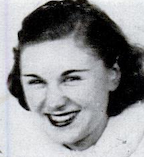Anna Sosenko
Anna Sosenko (June 13, 1909 – June 9, 2000) was an American songwriter and impresario who flourished in the 1930s. She is perhaps best known as a manager and writer for cabaret singer Hildegarde, for whom she wrote "Darling, Je Vous Aime Beaucoup".
Anna Sosenko | |
|---|---|
 Anna Sosenko, from a souvenir photograph taken in Paris in 1934; published in Life magazine in 1943. | |
| Born | June 13, 1909 Camden, New Jersey |
| Died | June 9, 2000 New York City |
| Occupation | Songwriter, theatrical producer, manager |
Early life
Anna Sosenko was born in Camden, New Jersey, the daughter of Simon Sosenko and Rebecca Sosenko. Her mother ran a restaurant and boarding house.[1][2]
Career
Managing Hildegarde
Sosenko is perhaps best known as the "formidable"[3] manager and writer for American cabaret singer and fashion celebrity Hildegarde,[4] for whom she wrote "Darling, Je Vous Aime Beaucoup" (1935).[1] "I made her a sensation long before she was a sensation," Sosenko said of her work, crafting Hildegarde's exotic public persona.[5] "Her ingenuity, her inventiveness, her organizational genius and her undying faith in her merchandise stamp Miss Sosenko as just about the smartest manager in show business today," declared journalist George Frazier, in a Life magazine profile of the pair in 1943.[2] Sosenko produced The Raleigh Room (1945-1947), a radio program starring Hildegarde, with Alan Jay Lerner as head writer.[5][6]
In the 1960s Sosenko managed another singer, Felicia Sanders.[7]
Producer and collector
In 1959, Sosenko co-produced a stage adaptation of Irving Stone's The Passionate Journey.[8] She promoted Jacqueline Susann's first novel, Every Night, Josephine.[9] In the 1970s and 1980s, she produced star-studded benefit shows, including tributes Mary Martin, Ethel Merman, and Richard Rodgers.[10] She helped develop the Songwriters’ Hall of Fame, now known as the National Academy of Popular Music.[11]
Sosenko had a large collection of theatrical memorabilia,[12] and in 1965 opened a small gallery[13] selling and trading such materials near Lincoln Center.[9][11] She exhibited some of these at the Museum of the City of New York,[6] and eventually donated her collection to several theatre history archives, including the Library of Congress.[1]
Personal life and legacy
Sosenko lived and worked with Hildegarde from 1933.[5][14] The pair collected art, including works by French impressionists;[15] that collection was sold when they separated in 1955.[16] They reconciled late in life, and even performed together. Sosenko died in 2000, four days before her 91st birthday.[1][3] The bulk of her assets were, upon her death, transferred to the Anna Sosenko Assist Trust, which provides small grants "to aid and enhance the career development of worthy and talented individuals in need of such assistance in the performance areas of theatre, opera or concert."[17]
References
- Nemy, Enid (2000-06-11). "Anna Sosenko, 90, Producer, Songwriter and Stars' Friend". The New York Times. ISSN 0362-4331. Retrieved 2020-06-19.
- Frazier, George (November 1, 1943). "Hildegarde: It will gross $150,000 this year for the firm of Sell and Sosenko". Life: 69–76.
- Hawtree, Christopher (2000-07-25). "Anna Sosenko". The Guardian. ISSN 0261-3077. Retrieved 2020-06-19.
- Garnett, E. B. (1944-01-02). "Hildegarde: A Cinderella in Glad Rags". The Kansas City Star. p. 23. Retrieved 2020-06-19 – via Newspapers.com.
- Gallamore, Monica Storme (2018-03-28). The Incomparable Hildegarde: The Sexuality, Style and Image of an Entertainment Icon. McFarland. pp. 9–10, 67–68. ISBN 978-1-4766-6770-6.
- "Anna Sosenko papers". Billy Rose Theatre Division, New York Public Library. Retrieved 2020-06-19.
- Hughes, Alice (1963-02-10). "Ill Wind Blows Fair for Felicia". The Brooklyn Daily Eagle. p. 29. Retrieved 2020-06-19 – via Newspapers.com.
- Funke, Lewis (April 26, 1959). "Gossip of the Rialto". The New York Times. p. X1 – via ProQuest.
- Woollen, Phyllis (1971-01-08). "Anna Sosenko and Hildegarde's Fame". The Lincoln Star. p. 8. Retrieved 2020-06-19 – via Newspapers.com.
- "Anna Sosenko Sets Playhouse Gala Show". The Central New Jersey Home News. 1984-10-16. p. 9. Retrieved 2020-06-19 – via Newspapers.com.
- Seligsohn, Leo (1977-01-27). "Who's Anna Sosenko? The Guardian of Theater Memories". The Cincinnati Enquirer. p. 28. Retrieved 2020-06-19 – via Newspapers.com.
- Bradford, Barbara T. (1970-08-02). "New Yorker Prizes Collections". El Paso Times. p. 31. Retrieved 2020-06-19 – via Newspapers.com.
- Roesch, Roberta (1965-10-26). "Anna Sosenko Shows How Girls Can Make Hobby Stepping Stone". The Record. p. 33. Retrieved 2020-06-19 – via Newspapers.com.
- Monahan, Kaspar (1949-09-28). "Show Shops: Meet Anna, Hildegarde's Dynamic Partner". The Pittsburgh Press. p. 28. Retrieved 2020-06-19 – via Newspapers.com.
- "Hildy and Anna Go Shopping for Art" Variety (Dec 10, 1947): 35. via ProQuest
- "Vaudeville: Hildy-Sosenko's Amicable Split After 20 Years" Variety (May 18, 1955): 61. via ProQuest.
- "About the Trust." The Anna Sosenko Assist Trust. Accessed January 1, 2020.
External links
- Anna Sosenko on IMDb
- Anna Sosenko at the Internet Broadway Database
- The Anna Sosenko Trust
- Monica S. Gallamore, "Introducing the incomparable Hildegarde: The sexuality, style, and image of a forgotten cultural icon" (PhD diss., Marquette University, 2012). A dissertation about Sosenko and Hildegarde's public and private relationship.